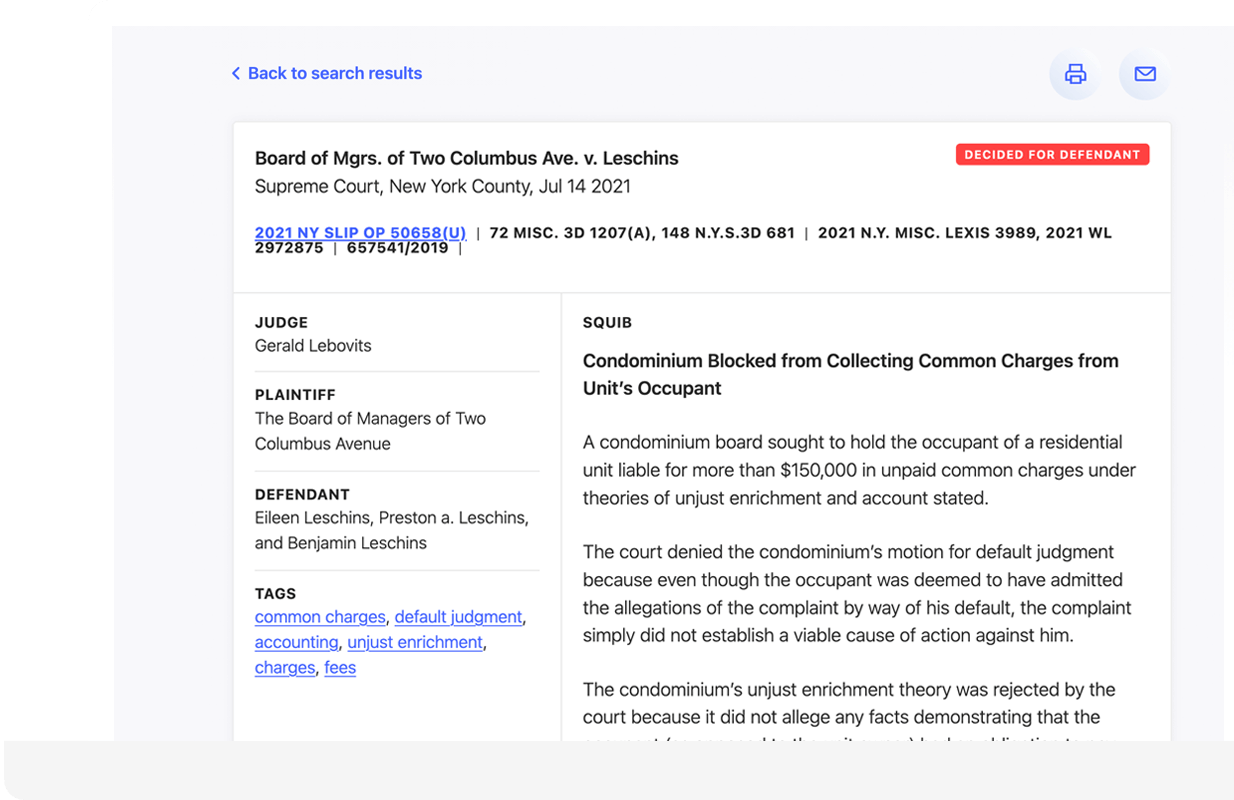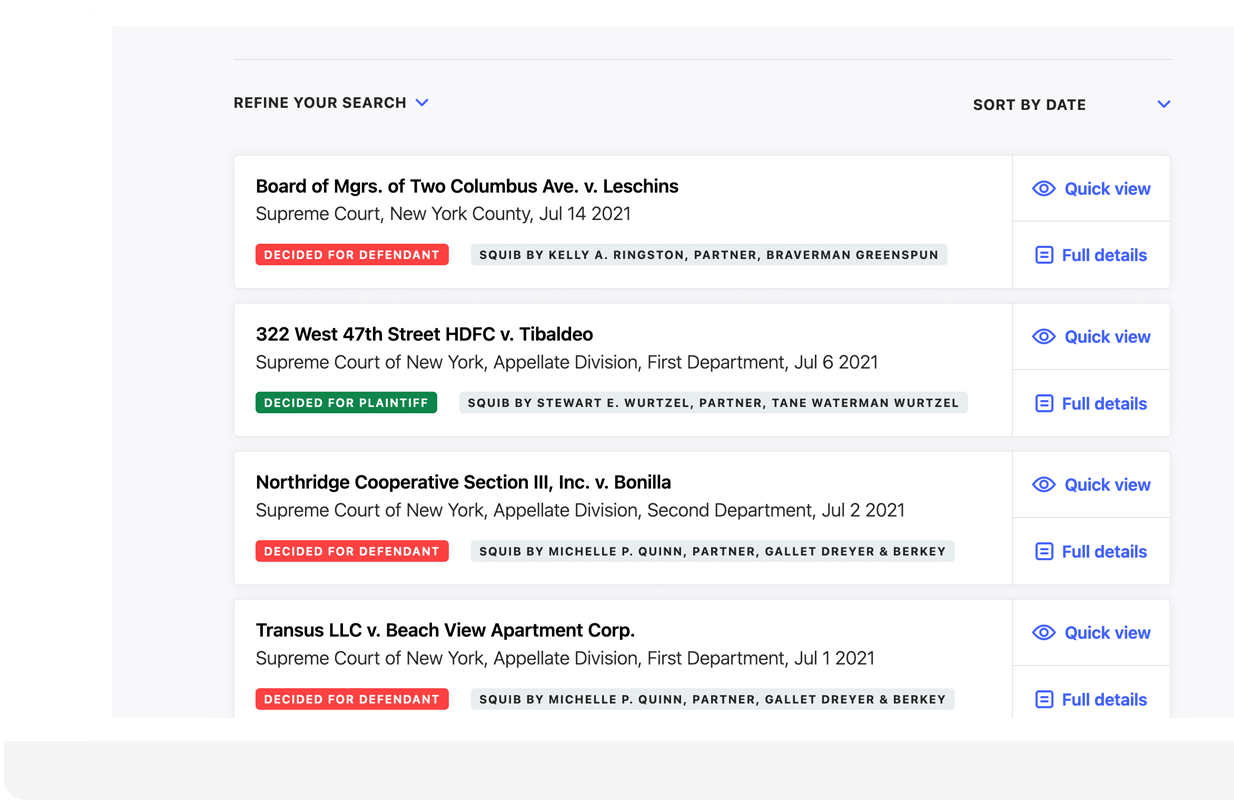Legal Decisions…Simplified and Specific.
A distinguished panel of New York co-op/condo attorneys analyze recent NY co-op/condo decisions. Subscribers receive a monthly PDF Digest of these case summaries and takeaways, an Advance Sheet of co-op/condo court cases recently decided, and access to the searchable Tracker database.
Take a Test Drive for $130-Day Test Drive. Cancel Anytime.
The Specifics of Search Success…
Addressing the specific and unique needs of today’s niche community of New York's co-op and condo professionals, Case Law Tracker does the heavy lifting—combing through and drawing out the cases most relevant to your needs.
Case Summaries
Focusing only on co-op and condo cases, practicing attorneys in this field prepare case summaries and useful takeaways - helping you understand what the case is about so you can quickly determine if it benefits you.
Case View
Our Quick View feature enables you to instantly determine if the case is relevant to your needs and provides you with a fast click to the full details of the case including judges, case history, as well as an active slip op link to related court documents.
Monthly Digest & Monthly Advance Sheet
A pdf Digest of all co-op/condo cases added to the database is emailed monthly to you. Plus, to keep you up to date on what the courts have most recently decided, you'll receive, monthly, an Advance Sheet with case names, decision and docket links, judges, and brief decision excerpts.
Searchable Database
Speeding you to exactly what you need, our robust search offers: a simple quick search; dropdown menus to refine that search; and powerful filtering capability that lets you drill down even further by court, judge, residence, tag, and date.
Advisory Panel
Our experienced advisory committee, comprised of industry-specific experts who truly understand the issues that matter to you, write the case summaries. They know what you need to know and help you get to that information as quickly and easily as possible.
Case Watch
Emailed twice-monthly, Case Watch focus on providing insight on one particularly relevant case—clearly explaining what happened, why it’s important, and what lessons can be learned within. Case Watch reaches two audiences: lawyers who subscribe to the Co-op & Condo Case Law Tracker and Habitat Magazine subscribers (co-op and condo board directors, property managers and other industry professionals).
Case Notes See all
Case Notes provides insight on one particularly relevant co-op or condo case—clearly explaining what happened, why it’s important, and what lessons can be learned within.
First published: Nov 2025
Don’t Dawdle Over Service DogsTAKEAWAY This case highlights the legal risks condo boards face when they postpone or mishandle disability-related accommodation requests. The Monarch board did not respond in a timely way to a request for a service dog, asked for medical records despite the condo having a stated policy against doing so and hired a psychiatrist without ever giving a clear decision on the request. Boards should respond promptly, in writing, whenever an accommodation request is made. They should also understand what qualifies as a disability under the various federal and state statutes affecting disabilities and know what documentation they are legally allowed to request. Finally, because claims against individual board members can move forward if there are allegations of their personal involvement, board members should ensure requests are handled quickly, carefully, and consistently to reduce the risk of liability.
Read full articleFirst published: Nov 2025
A Tax Abatement TangleTAKEAWAY Challenging decisions made by city agencies is almost never straightforward. In a case like this, where the mistake seems to have come from the Department of Finance rather than the co-op, the real question becomes: who is responsible for fixing it? Should the shareholder have taken the lead, or was it the co-op’s job to push the agency for correction? What’s clear is that the situation snowballed. A relatively routine $4,000 assessment grew into a years-long dispute that ultimately cost Tracy Schusterman more than $100,000 in legal fees.
Read full articleFirst published: Nov 2025
From Clutter to CourtroomTAKEAWAY As our population ages, hoarding situations are becoming increasingly common. When direct efforts to gain a resident’s cooperation fail, boards can seek court orders requiring owners to clean up and correct hazardous conditions that threaten health, safety, or the well-being of other residents and the building. The evidence of the conditions should be as current and thorough as possible in order to accurately convey to the court the seriousness and exigency of the present circumstances. To prepare for such situations, boards should ensure they have up-to-date emergency contact information for all owners, which can be vital in resolving these issues quickly. In some cases, agencies such as Adult Protective Services can be brought in to provide support and intervention.
Read full article



